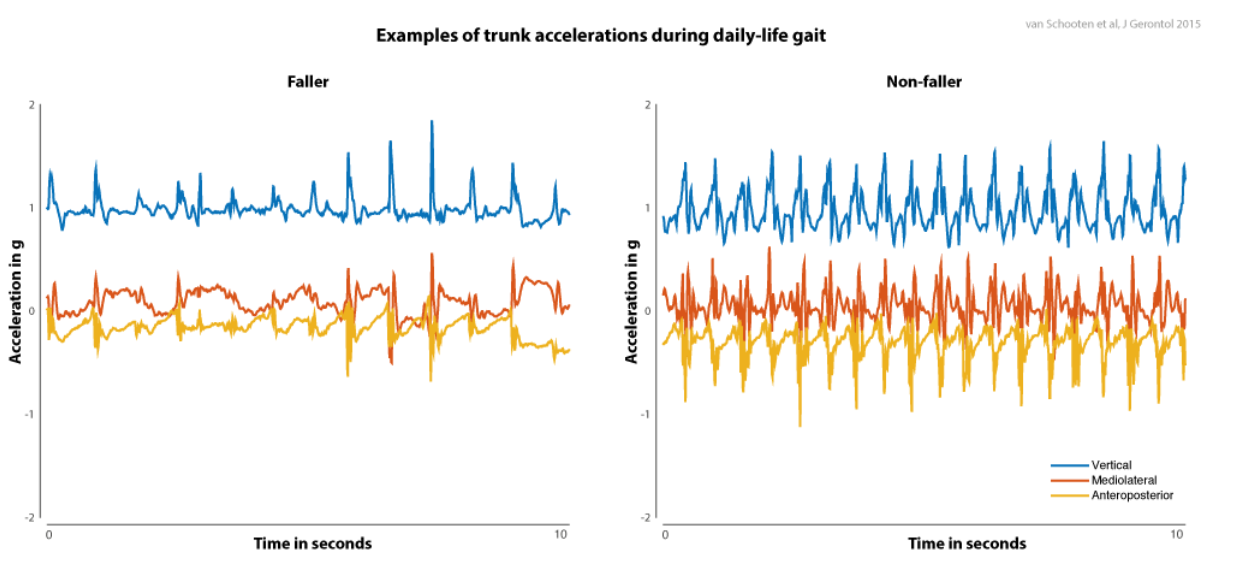Falls are a common problem for older people. They are among the leading causes of disability in this population and pose a growing burden on society. Fortunately up to 40% of falls can be prevented through timely intervention. To efficiently allocate people to interventions, we need to know who is at risk. Recent technological advances in wearable sensors for ambulatory monitoring allow for continuous daily-life monitoring of human behaviour. In our publication in Journals of Gerontology, we report on how we improved the identification of older people at high risk for falls using a trunk-worn accelerometer. We examined whether the amount and frequency of daily activities, and the quality of these activities, as obtained from this sensor, aid fall risk prediction.
How did we do it and what did we find?
169 older people with an average age of 75 years participated in our study. We asked them to wear an accelerometer (McRoberts’ MoveMonitor) for one week during their daily activities. This sensor provided us with their habitual amounts of daily activity and quality of gait. We also assessed commonly used clinical tests of memory, planning, depression, fear of falls and muscle strength. Subsequently, we followed the fall incidence of these people through fall diaries and monthly phone calls. Our results showed that 59 of the 169 older people fell at least once during the 6 months follow up. The results reveal that gait quality was predictive for falls. People who walked slower and less stable were more likely to fall (an example of the raw acceleration data can be found below). The clinical tests and accelerometry data provided complementary information that, combined, could predict falls with good accuracy (AUC 0.82). Our results further suggest that people with a low quality of gait had a higher risk for falls when they walked a lot, while the amount of walking was no problem for people with a good quality of gait.

What does it mean?
The study shows that trunk-worn sensors are promising to identify older people with a high risk of falls in a timely manner. This method could be implemented in clinical settings as a screening tool and may also hold promise for evaluating the effectiveness of interventions. The results further suggest that an individual’s physical capacity should match its physical activity level to avoid falls. Although this notion needs external validation, it has been suggested that some exercise programs may increase falls in frailer individuals, while they are effective in decreasing fall incidence in less frail individuals. This finding may be very relevant for individualization of fall prevention programs to increase physical activity in a safe way.
Publication
van Schooten KS, Rispens SM, Elders PJM, Lips P, Pijnappels M, van Dieën JH (2015). Ambulatory fall-risk assessment: Amount and quality of daily-life gait predict falls in older adults. J Gerontol A Biol Sci Med Sci, 70(5), 608-615. doi: 10.1093/gerona/glu225
About the Author

Kim van Schooten
Department of Human Movement Sciences, Vrije Universiteit Amsterdam
Kim van Schooten’s main research interests are balance control and ageing. Her research has focused on the assessment of gait stability and the amount of physical activity in relation with fall risk in older people. She currently focuses on characteristics of falls in frequent fallers and balance recovery strategies in impending falls. In the future, she aims to identify determinants of impaired balance control with ageing to reveal targets for the prevention of falls.
Kim is a postdoctoral fellow at the Department of Biomedical Physiology and Kinesiology, Simon Fraser University & the Centre for Hip Health and Mobility, University of British Columbia, Canada. The study presented here she performed as part of her doctoral work at the Department of Human Movement Sciences, Vrije Universiteit Amsterdam, the Netherlands.
Copyright
© 2018 by the author. Except as otherwise noted, the ISPGR blog, including its text and figures, is licensed under a Creative Commons Attribution-ShareAlike 4.0 International License. To view a copy of this license, visit https://creativecommons.org/licenses/by-sa/4.0/legalcode.
ISPGR blog (ISSN 2561-4703)
Are you interested in writing a blog post for the ISPGR website? If so, please email the ISGPR Secretariat with the following information:
- First and Last Name
- Institution/Affiliation
- Paper you will be referencing
